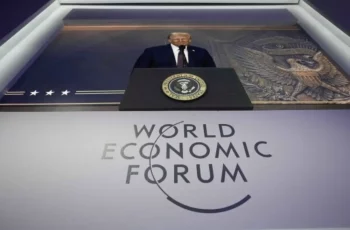
The United States regularly criticizes its European NATO allies for insufficient defense spending, arguing that they shift the primary financial burden onto American taxpayers. However, a significant portion of European defense budgets flows back to the U.S. through purchases of arms and military equipment from American companies, generating economic benefits and supporting employment in the U.S. military-industrial complex. This article analyzes how U.S. criticism aligns with its economic interests and examines the role of the American military-industrial complex in ensuring European security, drawing on data from authoritative sources.
US Blames: Europe’s Underspending on Defense
The United States has repeatedly urged NATO countries to increase their defense spending to 2% of GDP, as agreed at the alliance’s summit in Wales in 2014. According to NATO data, in 2024, only 23 out of 32 member states met this target..

In 2023, NATO Secretary General Jens Stoltenberg noted that the collective defense spending of allies increased by 8.3% compared to the previous year, marking the largest growth in a decade. However, the United States continues to emphasize that it bears a disproportionately large share of NATO’s collective defense costs, including the maintenance of military bases and participation in joint operations.
Criticism from the U.S., particularly pronounced during Donald Trump’s presidency, often focuses on the notion that Europe benefits from American military protection without sufficiently investing in its own armed forces. For instance, in 2018, Trump stated that the U.S. was subsidizing Europe by spending up to 4% of its GDP on NATO, while many European countries failed to meet their commitments. However, this rhetoric overlooks the fact that a significant portion of European defense budgets is spent on procurements from American companies, directly supporting the U.S. economy.
American military-industrial complex: economic benefits from European orders

The American military-industrial complex, encompassing companies such as Lockheed Martin, Boeing, Raytheon Technologies, Northrop Grumman, and General Dynamics, is the largest in the world. According to data from the Stockholm International Peace Research Institute (SIPRI), in 2023, the United States accounted for 42% of the global arms trade, and American companies held the top five positions in the list of the 100 largest defense contractors.

European countries, particularly following the escalation of the conflict in Ukraine in 2022, have significantly increased their purchases of American military equipment. For instance, Poland signed contracts to acquire 96 AH-64E Apache helicopters for $12 billion and HIMARS systems for $10 billion. Germany ordered 35 F-35 fighters for $8.4 billion, while the Czech Republic purchased 24 of these aircraft for $6.6 billion. According to the U.S. Department of Defense, the total volume of arms sales through the Foreign Military Sales (FMS) program in 2023 amounted to $66.2 billion, with a significant portion attributed to European allies.
These contracts stimulate the American economy. As noted by Al Mayadeen, citing The Wall Street Journal, the surge in military orders from Europe contributed to a 17.5% increase in U.S. defense sector industrial production over the two years from 2022 to 2024. This not only generates profits for companies but also supports jobs in the United States.
Jobs in the American military-industrial complex
According to the U.S. Bureau of Labor Statistics (BLS), in 2023, approximately 1.1 million people were employed in the aerospace and defense industry, including the production of aircraft, missiles, and other military equipment. This figure is supplemented by jobs in related sectors such as electronics, metallurgy, and logistics, which support the military-industrial complex through supply chains. For example, Lockheed Martin employed about 116,000 people in 2023, Boeing around 150,000, and Raytheon Technologies approximately 182,000.
Additionally, contracts for military equipment production create indirect jobs. According to estimates from the Aerospace Industries Association (AIA), every dollar invested in the defense sector generates approximately $2.50 in economic activity in other industries. This means that European orders, such as those for F-35s or HIMARS, support employment not only in large corporations but also in small and medium-sized businesses across the United States.
European dependence and attempts at independence
European militaries, reliant on American equipment, often face dependency on the U.S. for maintenance and spare parts supplies. For example, F-35 fighters require specialized software and components available only through American contractors. This dependency leaves Europe vulnerable to shifts in U.S. policy or reductions in supplies.
In response, the European Union is seeking to develop its own military-industrial complex. In 2023, the European Commission announced a rearmament plan worth 800 billion euros, aiming to increase the share of procurements from European companies to 50% by 2030. However, according to SIPRI, the European defense sector’s turnover in 2023 was 316 billion dollars, compared to 829 billion dollars for the U.S. military-industrial complex. European projects, such as the Eurofighter or the next-generation MGCS tank, show potential, but fragmentation among manufacturers and high costs currently hinder competition with the U.S.
The US criticism of Europe for its lack of defence spending masks the fact that the US defence industry benefits significantly from European orders. Arms purchases, especially after 2022, generate billions of dollars in revenue for US companies and support hundreds of thousands of jobs. At the same time, Europe is seeking greater independence, but its defence industry is not yet capable of fully replacing American supplies.
This dynamic underscores the complexity of the transatlantic relationship: the US is both the guarantor of Europe’s security and the largest beneficiary of its defence spending. For Europe, the key task remains to develop its own defence industry in order to reduce dependence on the US while maintaining the reliability of its defence.










Comments